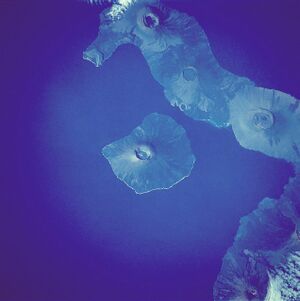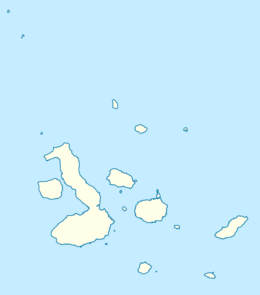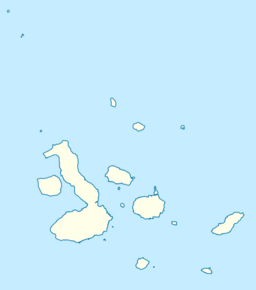Earth:Fernandina Island
| Geography | |
|---|---|
| Location | Galápagos Islands, Ecuador |
| Coordinates | [ ⚑ ] : 0°22′S 91°33′W / 0.37°S 91.55°W |
| Archipelago | Galápagos Islands |
| Area | 642 km2 (248 sq mi) |
| Highest elevation | 1,476 m (4843 ft) |
| Highest point | Volcan La Cumbre |
| Administration | |
Ecuador | |
| Province | Galápagos |
| Fernandina | |
|---|---|
 Fernandina Island (centre) and Isabela Island | |
| Highest point | |
| Peak | Volcan La Cumbre |
| Elevation | 1,476 m (4,843 ft) |
| Coordinates | [ ⚑ ] 0°22′S 91°33′W / 0.37°S 91.55°W |
| Geography | |
Galápagos Islands, Ecuador | |
| Geology | |
| Mountain type | Shield volcano |
| Last eruption | 2020[1] |
Fernandina Island (Spanish: Isla Fernandina) is the youngest and third largest island in the Galapagos, as well as the furthest west. It has an area of 642 km2 (248 sq mi) and a height of 1,476 m (4,843 ft), with a summit caldera about 6.5 km (4.0 mi) wide. It is younger than Isabela, being only less than one million years old since its formation. Like the other islands, it was formed by the Galápagos hotspot. The island is an active shield volcano that has most recently erupted in January 2020.
Names
Fernandina is named in honor of King Ferdinand II of Aragon, one of the sponsors of Christopher Columbus's voyages. It was formerly known in Spanish as Isla de Plata ("Silver Island")[2] and in English as Narbrough[3] or Narborough Island, honoring Admiral John Narborough who commanded a British Navy squadron in the West Indies.[4] The name was bestowed by the English pirate William Ambrosia Cowley in 1684 and preserved for centuries thereafter.[4]
Geography
Ferdandina is the youngest and third largest island in the Galapagos, as well as the furthest west.[5] It has an area of 642 km2 (248 sq mi) and a height of 1,476 m (4,843 ft), with a summit caldera about 6.5 km (4.0 mi) wide. The caldera underwent a collapse in 1968, when parts of the caldera floor dropped 350 m (1,150 ft). A small lake has intermittently occupied the northern caldera floor, most recently in 1988. Due to the recent volcanic activity, the island does not present much plant life and has a mostly rocky surface. Visitors to Fernandina Island will be taken to see only the outskirts of the crater for safety reasons. Two types of lava flow can be observed, ʻaʻā and pāhoehoe.
Wildlife
Punta Espinoza is a narrow stretch of land where hundreds of marine iguanas gather in large groups on black lava rocks. The famous flightless cormorant inhabits this island as well as penguins, pelicans and sea lions. The Narborough Island tortoise is a highly elusive species of Galápagos tortoise restricted to the island, thought likely extinct when no sighting had been made for 113 years after 1906, one old female being found in 2019.[6]
Flora
Mangrove forests are also found on the island.
Volcanic history
Eruptions of La Cumbre have been recorded in 1825, 2009, 2018, and 2020.
See also
- Volcanoes of the Galápagos Islands
- List of volcanoes in Ecuador
References
Citations
- ↑ "Fernandina". Smithsonian Institution. https://volcano.si.edu/volcano.cfm?vn=353010.
- ↑ Kitchin, Thomas (1797), "South America", Kitchin's General Atlas..., London: Laurie & Whittle.
- ↑ McEwen (1988), p. 235.
- ↑ 4.0 4.1 McEwen (1988), p. 236.
- ↑ "Fernandina". galapagos.org. https://www.galapagos.org/about_galapagos/about-galapagos/the-islands/fernandina/.
- ↑ "Giant tortoise believed extinct for 100 years found in Galápagos". The Guardian. 21 February 2019. https://www.theguardian.com/environment/2019/feb/21/giant-tortoise-believed-extinct-for-100-years-found-in-galapagos.
Bibliography
- McEwen, Alec (July 1988), "The English Place-Names of the Galápagos", The Geographical Journal, 154, London: Royal Geographical Society, pp. 234–242, doi:10.2307/633849, https://www.jstor.org/stable/633849.
External links
- Special Report: Volcano Erupts on Fernandina Island. Charles Darwin Foundation
- Fernandina
- Benjamin Morell and the Galápagos Eruption of 1825
- Eruption on Isla Fernandina NASA Earth Observatory
 |





